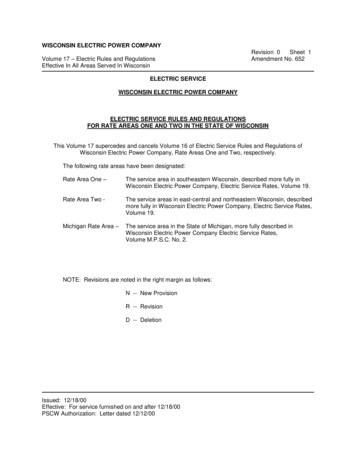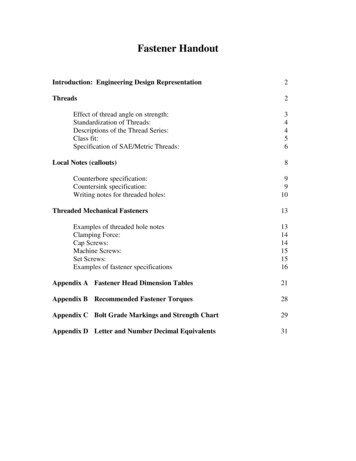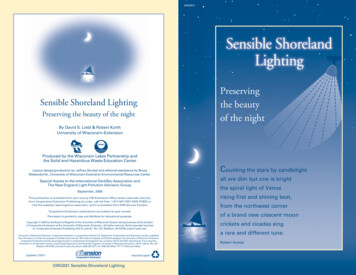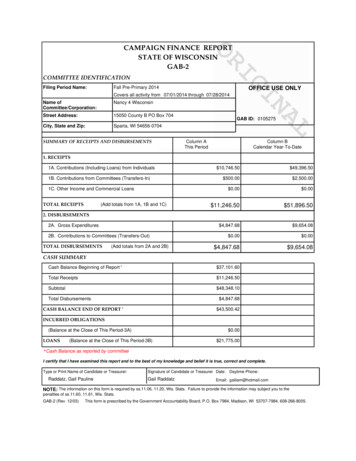
Transcription
WISCONSINWater-Resources InvestigationsUS. GEOLOGICAL SURVEYOpen-File Report 94-3211994
WATER-RESOURCES INVESTIGATIONS INWISCONSINby D.E. MaertzU.S. GEOLOGICAL SURVEYOpen-File Report 94-321Madison, Wisconsin1994
U.S. DEPARTMENT OF THE INTERIORBRUCE BABBITT, SecretaryU.S. GEOLOGICAL SURVEYGordon Eaton, DirectorFor additional information write to:Copies of this report can be purchased from:District ChiefU.S. Geological Suvey6417 Normandy LaneMadison, WI53719U.S. Geological SurveyEarth Science Information CenterOpen-File Reports SectionBox 25286, MS 517Denver Federal CenterDenver, CO 80225
CONTENTSProgramPageBasic data collection001Collection of basic records surface water.!00101Discharge ratings for tainter and roller gates at lock and dam no. 7 on theMississippi River at La Crosse, Wisconsin .10002Collection of basic records ground water. 11003Collection of basic records water quality .1300301Intergovernmental task force on monitoring Wisconsin water resourcescoordination pilot project. 1400302Collection of basic records Dane County program. 15004Collection of basic records sediment.16006FEMA flood-insurance study.18007Wisconsin water-use data file.19Interpretive studies035Low flow at outfall sites .20093Ground-water-quality appraisal of Wisconsin's aquifers.21109Regional flood-frequency study for urban and rural streams in Wisconsin .22110Effects of acid precipitation on lakes in northern Wisconsin .25129Long-term effects of acid precipitation on lakes in northern Wisconsin.25116Effects of acid precipitation on lakes in northwestern Wisconsin.27123Water resources of Wisconsin Indian reservations.29133Lake water-quality monitoring, chemical and biological monitoring ofselected lakes.31145Occurrence, transport, and simulation of PCB's in the Lower Fox River.33151NAWQA national-relations between land- and water-managementpractices and contaminant effects on aquatic organisms.3515401Ground-water control of the chemical evolution of Nevins Lake, Michigan.36164Superfund remedial response support, EPA Region V.37170Hydrologic investigations of wetland restoration and creation projects.38171Determination of sediment-reduction goals in priority watershed projects.3917201-05 Trends in water quality and stream habitat for priority watersheds .4017208-10 Trends in water quality and stream habitat for priority watersheds .4017213-14 Trends in water quality and stream habitat for priority watersheds .4017206Best-management practice evaluation .4217211A method for analyzing the effects of storm-water discharge on pollutantconcentrations in urban streams.4317212Lake Superior urban storm-water demonstration project .4417301Wisconsin lakes, assessment of the hydrology and phosphorus loading toFish and Mud Lakes, Dane County, Wisconsin.4517302Wisconsin lakes, Whitewater Lake, Wisconsin.4717303Wisconsin lakes, Silver Creek .4917304Wisconsin lakes, Devil's Lake water-budget model .5017306Wisconsin lakes, assessment of the water quality and trophic status ofPark Lake, Columbia County, Wisconsin.5217307Elkhart Lake hydrology.5417308Assessment of hydrology, trophic status, and lake-bed sediment ofStewart Lake near Mt. Horeb.55in
1830218303184185187188189190191192986Assessment of the hydrology and water quality of Lauderdale Lakes,Walworth County, Wisconsin.56Hydrologic investigation of the Pretty Lake watershed.58Western Lake Michigan drainages National Water-Quality Assessment(NAWQA).59Hydrologic and biogeochemical budgets in temperate lakes and theirwatersheds, northern Wisconsin.61Ground-water resources at the Kettle Moraine Springs Fish Hatchery,Sheboygan County, Wisconsin.63Mercury cycling in lakesAcidic lakes.64Hydrologic considerations associated with the artificial acidification ofLittle Rock Lake in Vilas County, Wisconsin.65Mercury accumulation, pathways, and processes.66Assessment of the hydrology, water quality, and biology of Delavan Lake .67Wetland retention of surface-water nutrient and suspended-sediment loadsinflowing to a eutrophic lake in southeastern Wisconsin .68Hydrogeology and ground-water use and quality, Fox Cities area, Wisconsin.69Lake Michigan tributary loading .71Trace-metal transport to streams.72Lake Superior tributary loading.73Regionalized estimates of loads to the upper Great Lakes .74Delineation of the potentiometric divide in the sandstone aquifer betweenthe Wolf River and Lower Fox River basins, Wisconsin .75Water-quality monitoring of industrial storm-water runoff.76Water-quality of urban storm-water runoff in Madison, Wisconsin .77Concentration of radon-222 in ground water and soil gas in the vicinity ofWisconsin Indian reservations.79Dane County regional hydrologic study .80Effects of microbial activity on sediment/water exchange of polychlorinatedbiphenyl congeners in the lower Fox River, Wisconsin .81Transport and biogeochemical cycling of PCB's in the Milwaukee Riverthe importance of algal dynamics .82Water resources at Wild Rose Fish Hatchery, Waushara County, Wisconsin .83Office of Surface-Water ResearchVelocity profiles under an ice cover.84Wisconsin District publications.85IV
ILLUSTRATIONSPageFigure 1. Organization chart of the U.S. Geological Survey, Water Resources Division,Wisconsin District.viii2. Location of offices in the Wisconsin District. ix3. Funding sources for the water-resources program in Wisconsin for the1994 fiscal year. xi4. Departure of runoff from long-term average runoff, 1993 water year andlong-term average runoff, 1951-80. xii5. Comparison of annual discharge at representative gaging stations to theirlong-term average discharge for water years 1916-93. xiii6. Comparison of discharge at representative gaging stations during wateryear 1993 with discharge for 1916-93. xiv7. Relation of seasonal water-table levels to long-term means.xx8. Location of continuous-record data-collection stations.59. Location of network observation wells. 1210. Location of crest-stage-gage data-collection stations.24
BASIC MISSION AND PROGRAMSU.S. Geological SurveyThe U.S. Geological Survey was established by an act of Congress on March 3, 1879, toprovide a permanent Federal agency to conduct the systematic and scientific "classification of thepublic lands, and examination of the geological structure, mineral resources, and products ofnational domain." An integral part of that original mission includes publishing and disseminatingthe earth-science information needed to understand, to plan the use of, and to manage the Nation'senergy, land, mineral, and water resources.Since 1879, the research and fact-finding role of the U.S. Geological Survey (USGS) hasgrown and has been modified to meet the changing needs of the Nation it serves. As part of theevolution, the USGS has become the Federal Government's largest earth-science research agency,the Nation's largest civilian map-making agency, the primary source of data on the Nation'ssurface-water and ground-water resources, and the employer of the largest number of professionalearth scientists in the Nation. Today's programs serve a diversity of needs and users. Programsinclude:Conducting detailed assessments of the energy and mineral potential of land and offshoreareas.Investigating and issuing warnings of earthquakes, volcanic eruptions, landslides, and othergeologic and hydrologic hazards.Conducting research on the geologic structure of land and offshore areas.Studying the geologic features, structure, processes, and history of the other planets of oursolar system.Conducting topographic surveys and preparing topographic and thematic maps and relatedcartographic products.Developing and producing digital cartographic data bases and products.Collecting data on a routine basis to determine the quantity, quality, and use of surface waterand ground water.Conducting water-resource appraisals to describe the consequences of alternative plans fordeveloping land and water resources.Conducting research in hydraulics and hydrology, and coordinating all Federal water-dataacquisition.Using remotely sensed data to develop new cartographic, geologic, and hydrologic researchtechniques for natural resources planning and management.Providing earth-science information through an extensive publications program and anetwork of public access points.Along with its continuing commitment to meet the growing and changing earth-science needsof the Nation, the USGS remains dedicated to its original mission to collect, analyze, interpret,publish, and disseminate information about the natural resources of the Nation providing "Earthscience in the public service."VI
Water Resources DivisionThe mission of the Water Resources Division (WRD) is to provide the hydrologicinformation and understanding needed for the optimum utilization and management of theNation's water resources for the overall benefit of the people of the United States. This mission isaccomplished, in large part, through cooperation with other Federal and non-Federal agencies, by:Collecting, on a systematic basis, data needed for the continuing determination andevaluation of the quantity, quality, and use of the Nation's water resources.Conducting analytical and interpretive water-resource appraisals describing the occurrence,availability, and physical, chemical, and biological characteristics of surface water andground water.Conducting supportive basic and problem-oriented research in hydraulics, hydrology, andrelated fields of science to improve the scientific basis for investigations and measurementtechniques and to understand hydrologic systems sufficiently well to quantitatively predicttheir response to stress.Disseminating the water data and the results of these investigations and research throughreports, maps, computerized information services, and other forms of public releases.Coordinating the activities of Federal agencies in the acquisition of water data for streams,lakes, reservoirs, estuaries, and ground water.Providing scientific and technical assistance in hydrologic fields to other Federal, State, andlocal agencies, to licensees of the Federal Energy Regulatory Commission, and tointernational agencies on behalf of the U.S. Department of State.vn
Merrill P.O.Jim GeorgeRice Lake P.O.Jack FreshwatersPublications UnitFigure 1. Organization chart of the U.S. Geological Survey, Water Resources Division, Wisconsin District.Madison P.O.Joe HabaleJim KrohelskiPeter HughesJohn ElderRick GroverHydrogeologic Studiesand Data SectionResearchAdvisorAdministrativeUnitWarren A. GebertEnvironmentalStudies SectionCharles PetersNAWQA ProgramHydrologic Systemsand Data SectionHerb GarnComputer ApplicationsUnitBob BodohOffice of District Chief:Water Resources Division, Wisconsin District
n204060 Miles88 aRice Lake(Held office)Madison:' 7D/sWcf Office - NdmsnOy]lJaheJ(Held "office - Seybold floadj.Figure 2. Location of offices in the Wisconsin District.IX
FUNDING SOURCESState AgenciesIllinois Department of TransportationWisconsin Department of Natural ResourcesWisconsin Department of TransportationWisconsin Geological and Natural History SurveyWisconsin Department of JusticeIndian TribesLac du Flambeau Band of Lake Superior ChippewaMenominee Indian Tribe of WisconsinOneida Tribe of Indians of WisconsinStockbridge-Munsee Band of Mohican IndiansLake DistrictsLocal AgenciesAlma/Moon Lake DistrictBrown County Planning CommissionBalsam Lake Protection and Rehabilitation DistrictCity of BarronBig Muskego Lake DistrictCity of Beaver DamCity of MuskegoCityofBrookfieldDane County Lakes and Watershed CommissionCity of Fond du LacDruid Lake Protection and Rehabilitation DistrictCityofHillsboroEagle Spring Lake Management DistrictCity of MadisonElkhart Lake Improvement AssociationCity of MiddletonFowler Lake Management DistrictCity of PeshtigoGreen Lake Sanitary DistrictCity of SpartaLake Keesus Management DistrictCity of ThorpLauderdale Lakes Management DistrictCity of WaupunLittle Arbor Vitae Lake DistrictDane County Regional Planning CommissionLittle Green Lake Protection and Rehabilitation DistrictDane County Department of Public WorksLittle Muskego Lake DistrictDarboy Sanitary District #1Little St. Germain Lake DistrictFontana/Walworth Water Pollution Control Commission Marinette County Land Conservation DepartmentGreen Bay Metropolitan Sewerage DistrictOkauchee Lake DistrictGreenville Sanitary DistrictPark Lake Management DistrictKaukauna Electric and Water UtilitiesPotters Lake Rehabilitation and Protection DistrictKimberly Water Works DepartmentPowers Lake Management DistrictMadison Metropolitan Sewerage DistrictPretty Lake Protection and Rehabilitation DistrictRock County Public Works DepartmentUpper Nemahbin Lake Management DistrictSoutheastern Wisconsin Regional Planning Commission Wolf Lake Management DistrictTown of BarabooTown of AuburnTown of Menasha Sanitary District #4Town of Cedar LakeVillage of Little ChuteTown of DelavanVillage of WittenbergTown of KansasvilleTown of MeadOther Federal AgenciesTown of NorwayU.S. Army Corps of Engineers,Town of St. GermainDetroit DistrictTown of SummitRock Island DistrictTown of TroySt. Paul DistrictTown of WaterfordVicksburg, MSVillage of Lake NebagamonFederal Emergency Management AgencyVillage of Oconomowoc LakeFederal Energy Regulatory Commission licenseesWind Lake Management DistrictU.S. Environmental Protection Agency
Lake Districts142,0002%Local Agencies385,0006%uses3,632,00056%Other Federal Agencies821,00013%Total Funding 6,445,000Figure 3. Funding sources for the water-resources program in Wisconsin for the 1994 fiscal year.XI
SUMMARY OF 1993 HYDROLOGIC CONDITIONSStreamflowThe statewide average precipitation of 38.79 inches for the 1993 water year was 122percent of the normal annual precipitation of 31.77 inches for water years 1961-90. Averageprecipitation values ranged from 103 percent of normal in northwestern Wisconsin to 150percent of normal in southwestern Wisconsin (Pamela Naber Knox, UW-Extension, Geologicaland Natural History Survey, written commun., 1993).Runoff was variable for rivers throughout the State ranging from 99 percent in northcentral Wisconsin to 278 percent in southwestern Wisconsin. Departure of runoff in the 1993water year from long-term average runoff is shown in figure 4, along with long-term averagerunoff for the period 1951-80. Runoff was lowest (99 percent of the average annual runoff from1936-93) for the Wisconsin River at Rainbow Lake near Lake Tomahawk. Runoff was highest(278 percent of the average annual runoff from 1939-93) for the Pecatonica River at Darlington.The average annual runoff for the 1993 water year was the maximum for the period of record at33 long-term stations (more than 10 years of record) in the southern half of Wisconsin.A comparison of the annual discharge for the individual water years (1916-93) at theOconto River near Gillett, Jump River at Sheldon, and Sugar River near Brodhead is shown infigure 5, The comparisons of monthly and annual discharges for the 1993 water year todischarge for a 78-year base period at the same three gaging stations are shown in figure 6.Spring runoff from snowmelt and major storms, in the period March through September1993, caused floods with discharges that equalled or exceeded those with a recurrence intervalof 10 years (Krug and others, 1991) at a number of crest-stage gage and gaging stations.EXPLANATIONPercent80 to 120Greater than 120 to 160Greater than 160 to 200Greater than 200 to 240II Greater than 240 to 280Figure 4. Departure of runoff from long-term average runoff, 1993 water year (left) and longterm average runoff, 1951-80 (right)xn
05436500 SUGAR RIVER NEAR BRODHEAD800600Long-termaveragedischarge-. V.400.III.lull,. 90200005362000 JUMP RIVER AT IL.,,,.1jJ 601970198019902000 04071000 OCONTO RIVER NEAR GILLETT12001000Long-termaveragedischarge8001 (iin11'1 nf1 ! ir""1' ' ' 19902000WATER YEARFig
WATER-RESOURCES INVESTIGATIONS IN WISCONSIN by D.E. Maertz U.S. GEOLOGICAL SURVEY Open-Fi











